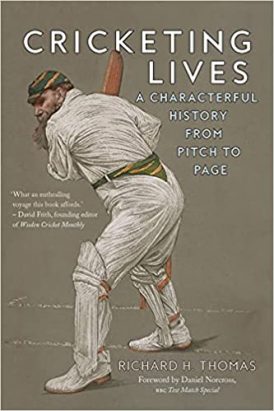Cricketing Lives
Martin Chandler |Published: 2021
Pages: 448
Author: Thomas, Richard H
Publisher: Reaktion Books
Rating: 4 stars

There was a time when books purporting to tell the story of the history of cricket appeared with some regularity. There hasn’t been one for some time however, no doubt in large part because that history is now so long, and has developed at such a pace in recent years that it would no longer be possible to tell the story within the covers of a single book. As far back as 1962 the publishers of the classic Altham/Swanton volume felt the need to split the subject into two volumes – it would surely now take four or five to do the job properly?
But I am assuming a conventional approach, concentrating on a standard historical text. As with most things there are other ways of tackling a task and Richard Thomas has found a hugely entertaining way to present the enduring story of how our splendid game got to where it is today. He even manages, and fair play to him for this, to end on an upbeat note. I hope he’s right, and that the doom-mongers amongst us are overthinking the issues that face cricket today.
The early pages of Thomas’s book make it clear that he is aiming at a market that will include those who have a limited knowledge of the game. He begins with a lengthy glossary, which defines cricketing terms, and some pretty basic ones too, but at least he does so with humour. At the end of the book, to reinforce the message, is another summary, this time of the laws of the game.
It is difficult to imagine anyone with the slightest interest in cricket not enjoying Cricketing Lives as Thomas takes his reader through the men who have made that history. There is little here by way of traditional history, and indeed as early as the second chapter Thomas looks at the start of the ‘Golden Age’. So the ancients of the game have only a few pages in which to stake their claims, but the racier tales of Alfred Mynn, Lumpy Stevens and ‘Silver’ Billy Beldham all put in an appearance.
The key to Thomas’s success is in part the ability to tell a story well, something which must be a given from a man who is described as Associate Professor in Journalism at Swansea University. But that ability is much enhanced by the depth of his knowledge. The chapter on Bodyline, for example, demonstrates a thorough understanding of that enduring controversy. It is not a difficult episode to write on but, because of the weight of words that have been written in the past, it is very difficult to do so well and, writing as a man who has read just about everything there is to read on the 1932/33 series, I much enjoyed Thomas’s take on it.
One of the problems with conventional histories is that the game’s finest individual moments seldom feature. Harold Gimblett does not merit a mention in Altham’s seminal work, but the story of his remarkable debut in 1935 is one of the finest there is. One of the advantages of Thomas’s approach is that he can reference that remarkable day in this history and his account is an excellent one, distilling the best of the account of the innings that Ralph Barker set down in Ten Great Innings, with a reminder of the demons faced by Gimblett that were recounted so movingly in David Foot’s superb biography.
Another important source of interesting people in cricket is amongst the scribes who write about it and, not constrained by any particular framework, Thomas has given himself free rein to devote a chapter to the contrasting styles of Neville Cardus, EW ‘Jim’ Swanton and John Arlott. In an earlier chapter he deals with, amongst other subjects, the importance of Wisden to cricket.
As I read through Cricketing Lives I was reminded of some of the comments that I recently made about Mayukh Ghosh’s book, In a League of Their Own. In many ways the books are entirely dissimilar, the much greater bulk of Cricketing Lives being the obvious difference. But both books have much to commend them to those whose journey into cricket literature is just beginning and in that respect those who have read and enjoyed In a League of Their Own would be well advised to move onto Cricketing Lives and, from there? To wherever their fancy takes them – by the time they have reached the end of Richard Thomas’s well presented book they are guaranteed to know those eras of the game’s history that appeal most to them.






Leave a comment